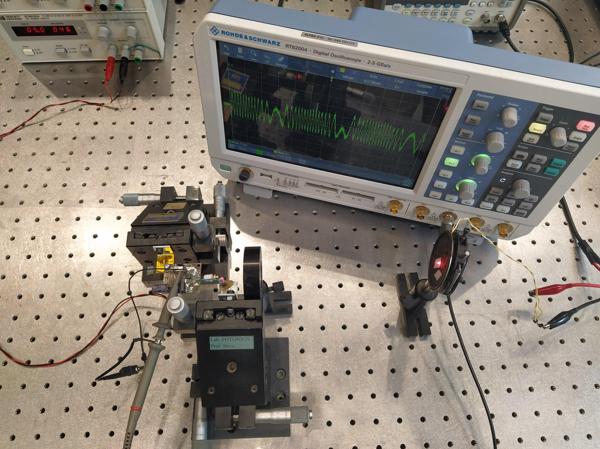The self-mixing interferometer (SMI) is a sort of optical radar capable of detecting extremely weak optical returns from a remotely located target and measuring the amplitude and phase of it. Different from the traditional radar based on launching a pulse to the target, the SMI uses a continuous coherent beam and operates as a coherent detector. Thanks to this feature, SMI has an unparalleled sensitivity to very small returns (down to 10-8 of the launched power) and can measure the phase – that is the optical pathlength down the target and back-with resolution of milliradian, that translates into optical pathlength attaining fractions of nanometers.
Usually and with semiconductor laser as the source of the SMI, the returning echo is picked by a detector placed on the rear mirror of the laser. However, thanks to the interaction with the active medium of the laser, the useful SMI signal is carried by the beam and is found everywhere along the beam, in particular also at the front output mirror of the laser. Here, a previous analysis has shown that the front mirror output exhibits the opposite sign (or, it is in phase opposition) respect to the rear mirror output. Thus, it may appear convenient to subtract the front output signal from the rear one, so as to double the signal amplitude. But, it is not actually just the amplitude to indicate an improvement, it is the signal-to-noise ratio the benchmark to be accounted, like in any measurement of physical quantities and in engineering applications.
About noise accompanying the signal, a simple conjecture indicates that it should be correlated on the two outputs, because it arises from the quantum nature of the photons in the beam, bouncing back and forth between the laser mirrors.
Therefore, it is argued that making the difference of back and front SMI outputs signals,
the SNR (Signal-to-Noise Ratio) should be improving, because the signal doubles while noise is partially cancelled. And, worth to note, improving the SNR at low level of optical returns has the consequence of improving the sensitivity of the SMI in the detection of weak signals and/or in the measurement of small vibration or displacements. In this regard, while the SMI already outperforms the traditional schemes of interferometers or detectors, any further improvement is very welcome because sensitivity improvement is never too much.
Professor Silvano Donati of the University of Pavia in Italy and Professor Michele Norgia of the Politecnico di Milano jointly analyzed this "differential mode" of operation of the SMI, both theoretically and experimentally. Related research results were published in Chinese Optics Letters Volume 19, Issue 9 (Silvano Donati and Michele Norgia. SNR improvement of 8.2 dB in a self-mixing laser diode interferometer by using the difference signal at the output mirrors [Invited]).

The self-mixing differential setup and waveforms seen at the oscilloscope
Theoretically, a model of quantum noise has been used in the paper which is a generalization of the well-known classical description based on assuming Poisson-distributed photons, or classical shot (or granular) noise, by introducing the second quantization in the model, but making it easy to use because translated in a semiclassical model. The second quantization is the necessary analytical tool because the first quantization just describes the optical field in terms of photons but doesn't convey any information about the correlation of optical fields. The correlation is central to the problem because it tells how much of two noises can be cancelled by a subtraction operation, much in contrast to the normal (uncorrelated source) subtraction which has the quadratic sum of fluctuations as the well-known result.
Interestingly, the second quantization has been translated into a semiclassical model- that is a model using the standard calculations - once the surprising novelty of the vacuum fluctuations is introduced, that accompanies not only propagating fields but also the zero-amplitude fields found at the unused ports - like the unused input of a beamsplitter. This surprising consequence of the field quantization underpins the new model of noise, that makes puzzling noise calculations easy.
Experimentally, the spectral noise density of the front and rear beams, and of their difference has been measured, and it is found that the differential-outputs SNR improves of 8.5±1 dB respect to the normal outputs. Theoretically, the model yields an improvement of 8.2 dB, so in a very satisfactory agreement with the experiment.
The importance of a better SNR stems from the improvement of both minimum amplitude of detectable signal, and minimum resolved optical pathlength. Explicitly, a factor 6.61 smaller for the detectable 10-8 power and 0.15 nm for the 1-nm resolution of pathlength measurement are gotten considered above.
Therefore, it may be concluded that the newly reported SNR improvement hints new handling methods to achieve the best performances out of a measuring Self-Mixing-Interferometer, useful for vibration and displacement measurements and for general purpose use of the SMI.


